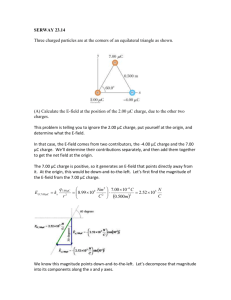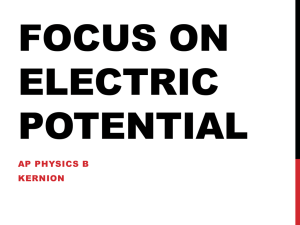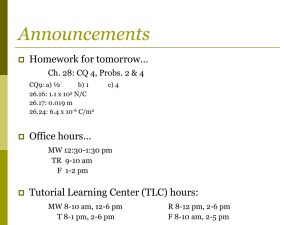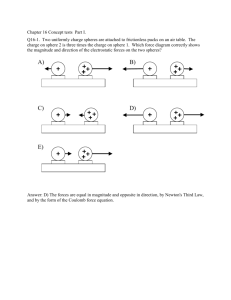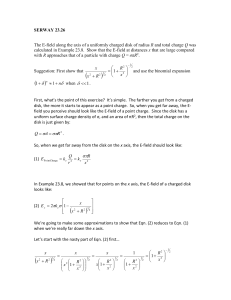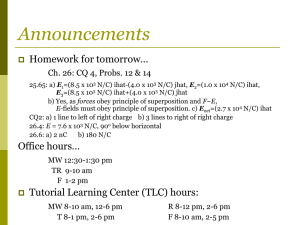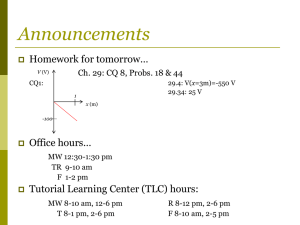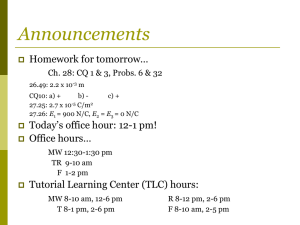Charges and Electric Fields - University of Colorado Boulder
advertisement
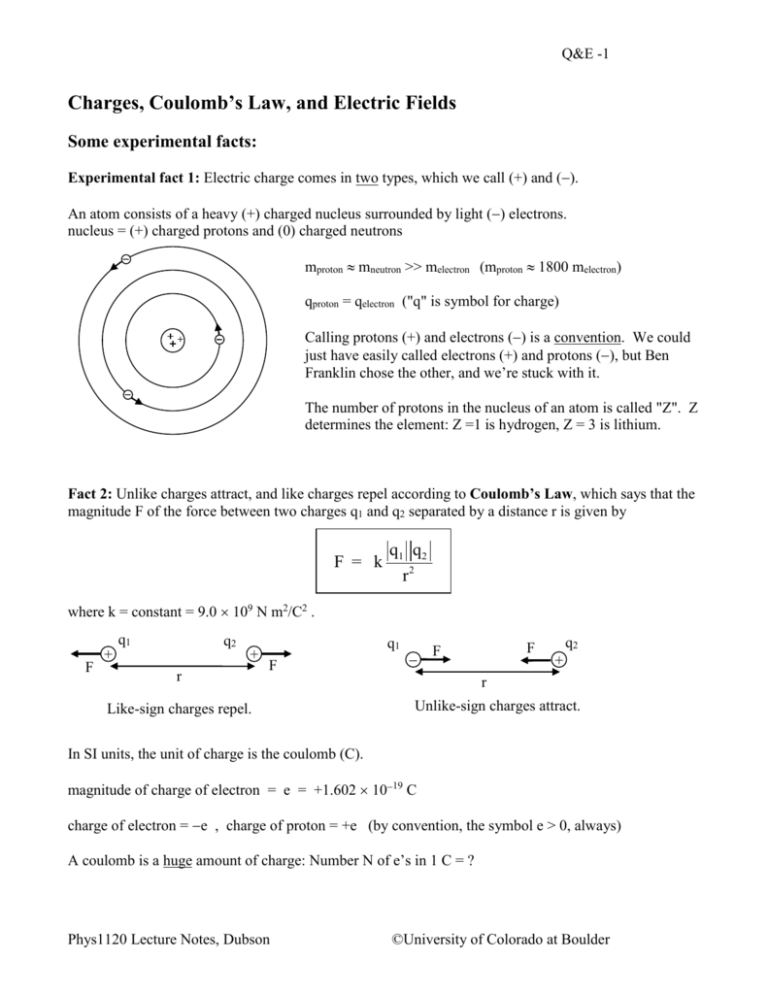
Q&E -1 Charges, Coulomb’s Law, and Electric Fields Some experimental facts: Experimental fact 1: Electric charge comes in two types, which we call (+) and (). An atom consists of a heavy (+) charged nucleus surrounded by light () electrons. nucleus = (+) charged protons and (0) charged neutrons mproton mneutron >> melectron (mproton 1800 melectron) qproton = qelectron ("q" is symbol for charge) Calling protons (+) and electrons () is a convention. We could just have easily called electrons (+) and protons (), but Ben Franklin chose the other, and we’re stuck with it. The number of protons in the nucleus of an atom is called "Z". Z determines the element: Z =1 is hydrogen, Z = 3 is lithium. Fact 2: Unlike charges attract, and like charges repel according to Coulomb’s Law, which says that the magnitude F of the force between two charges q1 and q2 separated by a distance r is given by F = k q1 q 2 r2 where k = constant = 9.0 109 N m2/C2 . q1 F q2 + + r q1 F Like-sign charges repel. F F q2 + r Unlike-sign charges attract. In SI units, the unit of charge is the coulomb (C). magnitude of charge of electron = e = +1.602 1019 C charge of electron = e , charge of proton = +e (by convention, the symbol e > 0, always) A coulomb is a huge amount of charge: Number N of e’s in 1 C = ? Phys1120 Lecture Notes, Dubson ©University of Colorado at Boulder Q&E -2 N ×e = 1C Þ N= 1C 1C = = 6.3´ 1018 - 19 e 1.6´ 10 C Fact 3: Electric charge is conserved. The net charge of an isolated system cannot change. It is impossible to create or destroy net charge. Except in nuclear or “high-energy” reactions, you can never create or destroy electrons, protons, and other charged particles – all we can do is move them around. In high energy reactions, we can create charged particles from energy (energy = mc2), but the particles are always created or destroyed in pairs (+1 and 1) so that the net charge is conserved. Aside: As far as we know, only 4 things in the universe are conserved: (1) Energy (2) Linear momentum (p = mv) (3) Angular momentum (spin = L = I) (4) Charge [Not quite true: in high energy physics, there may be other quantities, like “baryon number” that are conserved.] Fact 4: The charge e is the fundamental unit of charge. You never find a free particle in nature with charge = fraction of e. You only find charge = e or integer multiple of e. Statements (1) thru (4) are experimental facts. Why are they true? Why are there 2 kinds of charge, not 3? Why e = 1.6 1019 C, not 4.2 1019 C? Why is charge conserved? We don’t know! And to some extent, physicists don’t care. It is the primary goal of physics to describe how nature behaves; a secondary goal is to explain why it behaves that way. (Many theorists are looking to explain why, but no luck yet…) Notice that Coulomb’s law is similar to Newton’s Universal Law of Gravitation: Fgrav G m1m2 r 2 , Fcoul k q1 q 2 r2 Similar, except that there are two kinds of charge ( + and ), but only one kind (sign) of mass. Gravity is always attractive, but electrical force can be attractive or repulsive. Recall that force is a vector – a mathematical object that has a size (magnitude) and a direction. Forces add like vectors, not numbers. Example: Net force on an electron due to two nearby protons, each a distance r away, 90o apart as shown. r -e 90o r Net force = Fnet F1 F2 F1 q1 = +e F2 q2 = +e Phys1120 Lecture Notes, Dubson In this particular case, F1 F2 F k e2 r2 . ©University of Colorado at Boulder Q&E -3 Fnet 2F ( not 2F) Fnet 2 k e2 r2 Recall: F 2 1 F Fnet = 2 F 1 Here we have used the Superposition Principle: the net force on a charge due to other nearby charges is the vector sum of the individual forces: Fnet F1 F2 F3 ... , where F1 net force due to charge 1, etc. The Electric field (a new concept) Surrounding every charge (or group of charges) is a thing, called an electric field E (it is a vector thing) Definition: The electric field E at a point in empty space is a vector quantity which can be measured by the following procedure: place a small test charge q at that point, measure the force F on q due to all other charges. The electric field at that point is given by E Fon q q E-field at a point is the force per charge on a test charge placed at that point. Note! The E-field exists even if there is no test charge present to measure it. Similarly, a gravitational field surrounds the earth, even if there is no “test mass” nearby to measure the pull of earth’s gravity: gravitational field Fon m mg F 1 GMm GM g , magnitude g 2 m m m m r2 r (M = earth mass, m = test mass, r = distance from m to Earth’s center) The electric field is not just an mathematical invention; it is real. We cannot (usually) see it or smell it, but we can feel it. In some situations, you can see an electric field: visible light is a rapidly oscillating electric field (more on that later in the semester.) What is the E-field around a point charge Q? (Q = “source charge” = “source” of E-field, q = “test charge” or “probe charge”) Phys1120 Lecture Notes, Dubson ©University of Colorado at Boulder Q&E -4 source charge Q test charge +q r Fon q E Fon q q kQ 1 kQq ˆr ˆr 2 q r r2 ( r̂ pronounced"r-hat" is the unit vector pointing away from the origin, where Q is. r-hat has no dimensions). Magnitude of the Efield due to a point charge Q: v Q E = k 2 rˆ r If the source charge Q is positive, then the E-field points away from Q, in the direction of r-hat. If the source charge Q is negative then the Efield points toward Q in the direction opposite r-hat. This r r follows directly from the definition E = F / q . For instance, if both Q and q are positive then the force F points away from Q and so does E. If Q is negative and q is positive, then both F and E point toward Q. What if the test charge q is changed from positive to negative? Then the direction of the force F and the sign of q both flip, which leaves the direction of E unchanged. The size and direction of the E-field is independent of the test charge. The test charge is just an imaginary artifice which we use to measure something which is already there. The E-field around a positive charge points always from the charge, and decreases in magnitude with 1 distance r as E 2 . We can represent the E-field at various points in space by drawing a little dot at r those points and drawing an arrow coming out of that dot. The arrow represents the E-field at the dot point. Think of the E-field arrow as "packed into the point". The E-field arrow is not something "reaching from beginning to end of arrow". The E-field at a point in space exists at that point. Phys1120 Lecture Notes, Dubson ©University of Colorado at Boulder Q&E -5 Notice that E as r 0. The electric field diverges near a point charge. Fon q Again, what if the test charge q in E is negative? E-field still points away from positive source q charge Q, since both F changes direction and q switches sign, which leaves the vector E unchanged. The E-field points away from positive charges. It points toward negative charges. We can think of the interaction between charges in two different ways: “Action at a distance” vs. “Fields” “Action at a distance” : Coulomb’s Law suggests that two charges exert a force on each other through empty space, instantaneously. But Coulomb’s law is only valid for stationary charges. If charge 1 moves, it takes some time for charge 2 to sense the change. The more modern “field-view” is: Charge 1 creates an E-field around it. Charge 2 feels that field. If Charge 1 moves, it takes some time for the surrounding E-field to change, so it takes some time for charge 2 to react. The total E-field due to a collection of charges is the vector sum of the E-fields due to the individual charges: Q E total E1 E 2 E 3 E i , where E1 E1 k 21 , E2 = .. , etc r i Why? Superposition Principle says that if we place a small test charge q near other charges Q1, Q2, Q3,… , then the net force on q is Ftotal F1 F2 Ftotal F1 F2 E total E1 E 2 q q q Phys1120 Lecture Notes, Dubson ©University of Colorado at Boulder Q&E -6 Example: Electric fields (qualitative) Four point charges, labeled 1 through 4, all with the same magnitude q, are placed around the origin as shown. Charge 2 is negative, the rest are positive. What is the direction of the E-field at the origin? y 1 r r 2 The total E-field at origin is the vector sum Etot = E1 + E2 + E3 + E4 r r E=? (I'll use bold type to indicate vector.) x 3 4 1 Notice that E3 and E4 cancel since they have equal magnitude, but opposite directions. The total E-field points right. 2 E2 E2 Etot E3 E4 3 E1 4 E1 What would be the direction of the force on an electron (charge q = –e) placed at the origin? r r r r Since E = F / q , we have Fon q = q E . If q is negative, the direction of the force on q is opposite the direction of the E-field. So the force is to the left. F r r Fon q = q E –e E In this equation, the E-field is due to all the other charges, not the field due to the charge q itself. Example Electric fields (quantitative) Two charge Q1 = +2e and Q2 = 3e are placed as shown. What the x-component of the electric field at the origin? y r r r r E tot = E1 + E 2 Þ E tot,x = E1x + E2x Q2= –3e E1 = k r r Ex = ? Q1= +2e Phys1120 Lecture Notes, Dubson Q1 2e = k 2 2 r r , E2 = k Q2 2 ( 2r) = k 3e 2 r2 x (Have used the fact that the distance from the origin to Q2 is 2 r ) ©University of Colorado at Boulder Q&E -7 E1x = E1 , since E1 is along the x-axis. y Q2= –3e E 2x E 2 cos E 2 cos 45o 0.707 E 2 E2 E tot,x = E1x + E 2x = E1 Q1= +2e k 2e 3e + 0.707 k 2 2 r 2r x = [2 + 0.707(3 / 2)] k e e = 3.06 k 2 2 r r E-field due to Continuous distribution of charge Image a continuous distribution of charge with the charge spread out smoothly over the volume of some object. What is the electric field at some point p due to this volume of charge? A very small (infinitesimal) volume of the object has an infinitesimal charge dq. "dq" means a "little bit of charge" This little bit of charge dq creates an infinitesimal electric field dE. The total electric field E at p due to all the bits of charge is v E = dq p v dE ò . dE Example: A semi-infinite line of charge with charge per length = , units [] = C/m. What is the Efield at a distance d from the end of the line, as shown? dx E=? ++++++++++++++++++++++++++++++++++++++ x 0 d charge dq = dx x dx = "little bit of x" , dq = "little bit of charge" Coulomb's Law gives us the magnitude of the field dE due to the charge dq, a distance x away: dE = k dq k dq k l dx = = = " little bit of E due to little bit of charge dq" r2 x2 x2 Since all directions here are along the x-axis, we are only interested in dEx and can just drop the v v subscript x. So instead of working with the 3D integral E = ò dE , we work with the 1D integral Phys1120 Lecture Notes, Dubson ©University of Colorado at Boulder Q&E -8 ¥ E = ò dE = ò d k l dx kl = 2 x x ¥ d æ kl ö kl ÷ = 0 - çç= ÷ . ÷ çè d ø d Check units: [] = charge/length, so [k / d] has units of [k]´ ék q ù charge = ê 2 ú . Units check! 2 êë r úû length In 2D problems where the E-field has components along x and y, break the problem up into x- and ycomponents. v E = v dE ò Û v E = E x xˆ + E y yˆ = ò dE x xˆ + ò dE y yˆ Conductors vs. Insulators Most materials can be classified as conductor or insulator . A conductor is also called a metal; an insulator also called avdielectric. Metals (Cu, Al, Au, Ag, Fe…) conduct electricity. In metals, some of the electrons (conduction electrons) can move freely thru the metal. If there is an E-field, the conduction electrons move in response to the force F = q E, and so a flow of charge, or current, occurs. The inner core electrons are bound strongly to their nuclei, but the outer core, conduction electrons are unbound, free to move among the nuclei. Metals usually have 1 or 2 conduction electrons per atom. (In chemist talk: “valence = 2” means “2 conduction electrons per atom”.) Insulators (plastic, wood, ceramic, sulfur) do not conduct electricity. In insulators, all the electrons are strongly attached to their nuclei, and do not move (much), even if there is an E-field exerting a force on them. Metals are shiny, insulators are dull. The appearance is a consequence of the mobility of the electrons. Insulators can have an induced charge due to induced dipole moments. All atoms, some molecules, have no permanent dipole moment, but acquire an induced moment when an external E-field is applied. neutral atom E=0 polarized atom in external field E q +q d Phys1120 Lecture Notes, Dubson ©University of Colorado at Boulder Q&E -9 Recall from chemistry, that a dipole moment is associated with a pair of equal and opposite charges (+q v v and – q) separated by a distance d. The dipole moment p is a vector quantity defined as p = q d , where the vector d points from – to +. Some molecules, like H2O, have a permanent dipole moment. In an external E-field, the moments align. = H2O molecule = dipole moment moments align in E-field Induced Charge A charged object (+Q, say) brought near a neutral object induces a charge separation in the neutral object The equal and opposite charges on the two side of the object are called induced charge. Another way to describe this situation is to say that the E-field from the charge Q induces polarization charge. Notice that an induced charge always results in a net attraction to the source of the E-field. The positively-charge +Q is attracting the negatively-charged near side of the object and repelling the positively-charged far side. But the attraction to the nearby side is greater than the repulsion from the more distant side, so the net force is attractive. neutral object (coke can or block of wood) +Q brought near neutral object – Q brought near neutral object Phys1120 Lecture Notes, Dubson ©University of Colorado at Boulder Q&E -10 Electric Field Line Diagrams The electric field can be represented by a field line diagram. Instead of trying to show the E-field at a whole bunch of individual points (left diagram), we indicate the field everywhere with a field line diagram (right diagram) Field line diagram for (+) point charge. Rules for field line diagrams: 1) Field lines begin on positive charges, end on negative charges, or go off to/come in from infinity. Charge q Charge 2q 2) The number of field lines coming from or going to a charge is proportional to the magnitude of the charge: More field lines = bigger charge 3) The direction of the E-field at a point is the direction tangent to the field line at that point. 4) The magnitude of the E-field at a point is proportional to the density of field lines at that point. To be precise, the magnitude of the E-field is proportional to the number of field per area perpendicular to the field direction. More densely packed field lines = higher magnitude E-field. Phys1120 Lecture Notes, Dubson ©University of Colorado at Boulder Q&E -11 One last important fact about charges and E-fields: The E-field anywhere is always due to all the charges everywhere. To get the total E-field, must always add up all the E-fields due to all charges everywhere: Etot = E1 + E2 + E3 +… You cannot destroy or "block" the E-field due to a charge, but you can create a second E-field which cancels the first E-field. Phys1120 Lecture Notes, Dubson ©University of Colorado at Boulder

